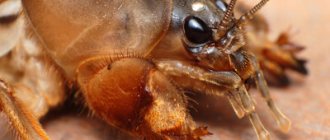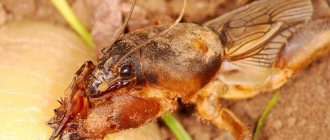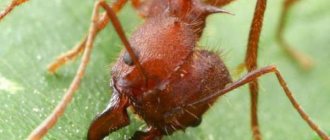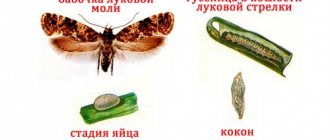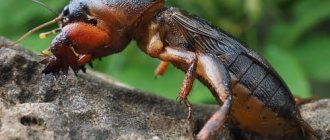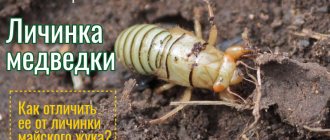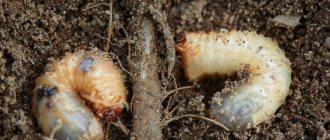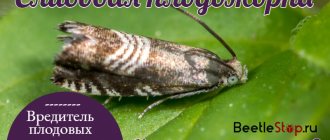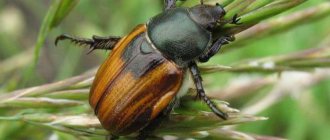The mole cricket (Gryllotalpidae) is an arthropod insect from the order Orthoptera, suborder long-whiskered, superfamily Cricketaceae, mole cricket family and mole cricket subfamily. It also has a more popularly known name - cabbage grass or mole cricket, spinning top, earthen crayfish. In this article we will tell you everything about this famous garden pest.
Mole crickets acquired this name due to their appearance, which is comparable to a bear. What similarities can this insect have with a bear? First of all, it is massive in size for an insect, also has large front legs with claws and a hairy body. As for the popular nickname cabbage, it was given because of the great love for eating young cabbage seedlings.
And the Latin name Gryllotalpa translates as mole-cricket, and they received this name due to the similarity of their body structure with a cricket and the ability to make sounds. What she has in common with a mole is the ability to burrow into the ground and extended front legs. The mole cricket received the name of the earthen crayfish because of the similarity of the front part with the crayfish (the structure of the head, strong shell, antennae, paws, vaguely reminiscent of claws). Top - for its resemblance to a wolf: the claws on the front paws resemble wolf fangs.
Medvedka - description and photo
As mentioned earlier, the mole cricket is a very large insect with small hairs on its body. Its shell is brown on top and yellow-brown underneath. The body length can reach from 3 to 5 centimeters, and the thickness is 1-1.5 cm. The head is located straight in relation to the body, and their axes completely coincide. The organs of the oral cavity are strong jaws that are directed forward, near them there are several pairs of small tentacles.
The eyes are large, located on the sides of the head, and are clearly visible. The insect's head is also decorated with a growing pair of antennae; they are very similar to the antennae of the cricket family, only somewhat shorter than those of the crickets themselves.
Interesting fact! The hearing organs of the mole cricket beetle are located not on the head, but on the front legs, namely on the legs, and have either an oval or slit-like shape. Crickets and grasshoppers have the same structure.
The insect's foredorsum is massive, flat, the lateral lobes slightly hang downwards. It is this feature that will help you recognize the cabbage plant. The front part and head have a strong chitinous shell, which is why it is compared to a crayfish. It helps the insect when digging underground tunnels, as it has the properties to successfully compact and push the earth.
The belly of the mole cricket is thick, its diameter reaches approximately 1 centimeter. In males and females, the anal and genital plates are located on it, but no ovipositor was found in females. The last plate of the abdomen has cerci, also called caudal appendages, which look like antennae. More details about mole cricket reproduction are described in a separate section below.
The kapustyanka has two pairs of wings - rear and front. The hind wings are a pair of long, wide, transparent, membranous wings with thin veins. At rest, they are folded and hidden under the elytra and resemble flagella. The insect actively uses these wings when flying, but the front wings are less involved. The forewings are somewhat shorter and have thick veins. In length they reach the middle of the body and the right wing is always under the left.
Interesting fact! You can determine what a male or female mole cricket looks like by the venation of the elytra, although this is quite difficult to do. Males do not have a mirror on the elytra, while in females the hind elytra have parallel longitudinal veins. There are also individuals that have no wings at all, but these are rare. The larvae at the development stage do not have wings at all.
Mole crickets have 3 pairs of limbs. The front legs are very strong, designed for digging the ground. The thigh and lower leg are widened, and the legs are shortened. There are four spikes on the shin, which are painted black, and two on the paw. They help the insect cling to the ground and dig through it. The hind legs are also strong, but they are intended only for movement and have from 1 to 4 spines. There is no jumping function.
origin of name
These insects became bearers of the title “mole crickets” for their large size, dark brown color, powerful front legs, and slightly downy body.
The second name of the individual is cabbage, attached due to its great love for the roots of young cabbage. Such a bug is also called a cricket - mole (translated from Latin), and for good reason - because the bug with its body structure fully resembles a cricket, it even creates a corresponding sound.
The name “mole” is also natural and quite logical - it is the front legs that help it easily overcome soil layers in search of the required food.
Also, a less common name is “top” - this name justifies its structure of the front legs. After all, they have sharp ends, slightly reminiscent of the sharp fangs of a wolf.
Mole cricket habitat
Cabbage grass is quite common throughout the world; they live almost everywhere except in cold regions: in Europe, Asia, India, Africa, America, India, Australia, and on many islands of the globe.
Most often they can be found in damp places, meadows or floodplains. In most cases, they live in underground passages and do not often come to the surface (only to change their habitat or search for food). They prefer to settle in warm soil fertilized with humus. Often found in vegetable gardens or near irrigation canals. They are attracted to soil with high groundwater levels and wetlands.
Signs of a mole cricket on the site
Even attentive gardeners often do not notice that mole crickets have appeared on the site. Meanwhile, pests leave obvious traces of their presence.
What signs indicate that there are mole crickets in the area:
- unexpected death of plantings;
- drying of young growth, which is easily removed from the soil;
- formation of rhizome damage in adult plants;
- holes on roots and fruits;
- the appearance of holes with a diameter of up to 2 cm near the plants with passages leading from them;
- detection of small earthen mounds and open holes with clearly defined edges. If you pry the ground with a shovel in this place, you may come across a mole cricket nest.
- in May–June (mating season) they begin to chirp, attracting females. The louder the male is, the more females come running to him. By chirping, gardeners judge the appearance of harmful insects.
Soon after the first signs appear, the pests crawl out. Mole crickets lead a closed lifestyle, but in search of food they come out of their burrows.
Lifestyle
They lead a secretive lifestyle. During the daytime, insects dig underground passages and eat plants and insects. The presence of the mole cricket in the garden is determined visually, the ground becomes covered with tubercles, these are underground tunnels that the mole cricket digs, holes appear in the ground and completely healthy crops can suddenly wither. This is because the insect eats the roots and the plant dies. At night they get out, during this period they can move between areas, and females can fly to the call of the male during the breeding season. They are also attracted to light. They run and fly quite quickly, and given that in nature these beetles often settle near bodies of water, they swim well. You can get acquainted with the appearance of the mole cricket beetle by looking at the photo below.
The daily bustle of an individual
Having previously examined the part about what a mole cricket looks like, we can say that the individual prefers to lead its lifestyle away from human eyes, namely in the upper layers of the soil.
With daily labor, these insects make trenches in the ground, eating everything in their path. At night, the mole cricket crawls out to the surface of the earth, trying to remain unnoticed.
What sounds does it make?
It is a known fact that by making sounds, they can communicate with each other. This happens both during the day and at night. Also, mole crickets can chirp while underground. Often only males do this, but females can also chirp. At night, the sounds are quite loud, harsh and low.
It is known that the sound made by mole crickets is discernible to humans at a distance of up to five hundred meters. If the cabbage plant is underground, of course, the sound will be more muffled, but still audible. Almost every one of us has at least once heard crickets “singing” in the evening, but the volume of a mole cricket is several times louder.
What does it look like
The mole cricket or cabbage moth is a beetle with a body length of 5–8 cm, living mainly underground. He has a powerful shell. Under it, the insect from time to time partially hides its head, on which two large compound eyes are located.
When describing the cabbage weed, we always note strong front legs with claws, reminiscent of beetle claws. Thanks to them, the beetle creates a system of complex passages underground. It also has wings that allow it to fly over distances of up to five meters.
The beetle got its name “mole cricket” because of its brown color and powerful clawed front legs. They evoke associations with the famous furry predator.
Reproduction
The mating period occurs in the spring and occurs underground. New offspring are born quickly; the first larvae appear already in the summer.
During the breeding season, mole crickets dig a complex network of passages and labyrinths under the plant, and they do this at a shallow depth (about 10-25 centimeters). Both the female and the male are engaged in this process. A small spherical nest is made under the roots, about the size of a chicken egg. There the female lays at least three hundred eggs (their number can increase to six hundred). They are oval in shape and small in size, about 2 mm. During this period, she carefully monitors the nest, protects it, compacts the walls, eats up the roots of plants that can cast a shadow or interfere, and also maintains normal air circulation and temperature.
The temperature regime is very important during this period; under good conditions, after about 15 days, the eggs hatch into cubs, who will live for another 1 month only under the supervision of the mother, without leaving the nest. After this, the female’s body is exhausted and she dies, and the cubs scatter and continue their development on their own, in particular, they dig tunnels and begin to look for food for themselves.
The larvae develop for a long time; depending on the region, the development time can vary from 1 year to 3 years. During the development period, they resemble an underdeveloped adult with a smaller size. They are also quite agile and can jump like grasshoppers; an adult mole cricket loses this ability. During the development period, they molt from 5 to 10 times.
Types of mole cricket
In general, mole crickets have no external differences from each other; they can only be distinguished by the number of chromosomes. However, there are several popular types.
Common mole cricket (Gryllotalpa)
The most popular type. The body dimensions are from 3 to 5 centimeters, the pronotum is about one and a half centimeters, the elytra reach a size of 2 cm, and the hind femur is from 1 to one and a half centimeters. It is brown in color, with a yellowish or olive belly. The head and back are black. Distributed throughout Europe, the Russian Federation, Asia, Africa and Australia.
African mole cricket (Africana) photo
It is smaller than usual. The body is from 2 to 3.5 cm, the pronotum is 0.5 - 1 cm, the elytra is 0.8 - 1.2 cm. It has a lighter color, brown-yellow above and yellow below. It is found in Asia, Ceylon, the Philippines, Korea, Russia, Australia, and the island of Madagascar.
Ten-toed (Neocurtilla hexadactyla)
Reaches sizes from 1.9 to 3 cm. Outwardly it is similar to the African one, but the upper part of the body is darker in color. They inhabit the entire territory of America.
Stepposa
It is very similar in appearance to the common mole cricket, but is somewhat smaller in size. The length of the body varies between 4-5.5 centimeters . This species can be found in Ukraine, Kazakhstan, Moldova, Mongolia, and Russia.
Single-spined mole cricket (Unispina)
It has medium sizes. Body length is from 3.8 to 4.4 centimeters. The pronotum is 1 – 1.3 cm, the length of the elytra is 1.5 – 1.7 cm. Both in appearance and in the way of life it does not differ from its fellows. The color is dirty brown above, yellow below. It can often be found on the shores of lakes or seas, where soil with a high salt content predominates.
Single-spined mole crickets live in the south of Ukraine, Belarus, the Russian Federation, Crimea, Georgia, Azerbaijan, Moldova, Kazakhstan, Tajikistan, China, Afghanistan and Iran.
What does it eat?
So, let's look at a photo of a mole cricket insect, what it eats and how to deal with it. Mole crickets often eat underground parts of plants, although they can climb to the surface and destroy seedlings or seeds. The diet of this insect is varied and depends on the region and place in which it lives. For example:
- In vegetable gardens , they damage many root vegetables, potatoes, cabbage, tomatoes, carrots, beets, beans, peppers, cucumbers, sweet potatoes, strawberries, radishes, pumpkins and much more. In general, we can say that cabbage grass can eat everything that grows in the beds.
- In the fields there is wheat, barley, rye, watermelons, melons, corn, hops, poppy seeds, soybeans, millet, oats and even tobacco.
- In the southern regions , citrus fruits, tea, cotton, and peanuts suffer.
- The gardens contain apricots, plums, pears and apples, and a cherry tree.
- In forests - it feeds on the roots of young oaks, pines, poplars, spruces and other trees growing there.
It is important to know! Few people know, but mole cricket beetles feed not only on plant foods; their diet includes earthworms, as well as the larvae of various insects and beetles.
Due to the terrifying appearance of the cabbage moth, many are interested in the question of whether the mole cricket bites or not? There is a clear answer: the mole cricket does not bite. The maximum that it can do is pinch a person with its front paws; the thorns can cause discomfort, but it cannot be called a bite. It is also absolutely non-toxic, so there is nothing to be afraid of. It poses the main harm to humans only through its lifestyle and diet. Fortunately, there are many ways to combat the mole cricket beetle.
Nutrition and harm
What does a bear eat? The answer to this question seems to be simple, but also complex at the same time. It would seem that if insects gnaw the roots of cultivated plants and eat up the roots of seedlings, then the answer is clear, but that was not the case.
Still, many biologists are inclined to believe that mole crickets give their main preference to animal food:
- worms;
- larvae of other insects;
- dead and living insects.
As for damage to root crops, this can happen because.
that the plant simply met the mole cricket on the way. This is supported by the habitat of these insects along river banks, where root crops usually do not grow. Is mole cricket dangerous for seedlings? Without a doubt. The fact is that when digging its tunnels, the mole cricket sometimes simply does not pay attention to small roots and digs its tunnels directly through the places where they grow. This underground armored train will not take an alternate route to bypass such an insignificant obstacle as the root of a cabbage seedling.
Since mole cricket larvae, as mentioned above, are an exact copy of an adult insect, they feed on almost the same larvae and worms as their parents. A weaker gnawing apparatus prevents the larvae from damaging root crops, but the soft, tender roots they encounter along the way will supplement their diet.
Fighting a mole cricket
Chemicals. Such devices, of course, are not used in their pure form. The grains of corn, rye, wheat or oats are pre-cooked. They are steamed, a little sunflower oil and poison are added. Previously, very strong poisons were used (zinc phosphide or dust), but now they are prohibited. They have been replaced by more modern drugs that are designed specifically to combat mole crickets; here it is important not to confuse the drugs that are intended for the mole cricket butterfly. Medvetox and Phenoxin-plus are well suited.
The advantage of modern poisons is that they are completely harmless to the soil, plants and beneficial insects . These chemicals only kill pests. Also, if you don’t want to make such mixtures yourself, stores sell ready-made poisoned seeds. They are applied to the soil in the spring, about a week before sowing crops. If the area is small, the seeds are buried at the intended planting site to a depth of 2-3 centimeters. If the area is large, they are scattered using a seeder.
It is also possible to use “false” seeding. To do this, poisoned seeds are sown on the site in advance, the pests eat them and die, after which the main seedlings or seeds are planted.
You can use another method - before planting in the ground, first soak the roots or tubers of plants in insecticides, for example, Aktara 25 WG. In this case, eating the roots of the plant, the pest dies.
During the growth period, you can water the soil with organophosphorus compounds. The roots of the plant will absorb this liquid, and the mole cricket will die by eating the root system of the crop.
Biological drugs. If chemical preparations are unacceptable for use, you can use biological agents that are made from insects that are enemies of the cabbage plant in their natural habitat. Such products can be purchased in specialized stores. Anti-Medvedka, Grizzly, Thunder helps well.
Agrotechnical measures. Regular use of this method will reduce the number or completely get rid of pests in your area. This includes regular autumn plowing, loosening the soil, and installing catch ditches.
Mechanical means. To catch mole crickets in this way, nests are dug and insects are destroyed. Pour water and sunflower oil into the burrows; in this case, the water will push the pests to the surface, and the oil will not allow them to breathe freely. You can also use solutions of kerosene or washing powder instead of water, however, such mixtures are best used in the most extreme cases, as they can harm plants.
A popular mechanical means of fighting the top will be the installation of various types of traps:
- Light traps - lanterns are placed on the site, and containers filled with kerosene or water are placed under them. Insects will fly into the light, hit the lamps and fall into the liquid. All that remains is to collect and destroy the pests in the morning.
- pieces of roofing felt, linoleum or plywood on the site After some time, mole crickets begin to gather under the trap; it is enough to suddenly raise the flooring and destroy the scattering insects.
- Having identified places where cabbage grass accumulates, you can dig a jar or bottle with bait into the ground. You can use beer as bait or coat the inside of the container with honey or jam. This will attract their attention, but once they get into such a vessel, they will not be able to get out. All that remains is to remove it and destroy the pests.
- You can also dig shallow holes (about 50 centimeters) and fill them with half-ripe manure. It is important to do this in the fall. Since mole crickets love warmth and in the winter they begin to look for shelter, manure will attract their attention, they will gather in it to overwinter. Then, when cold weather sets in, the holes are dug up and scattered around the area, the pests scatter and simply die from the cold. In this way, you can completely get rid of pests; the best option would be if all the neighbors in the summer cottage use this procedure.
- Manure traps can be installed in early spring . Scatter heaps of manure over the area; during this period, mole crickets begin to reproduce. After 20 days, they need to be dug up and, upon noticing the eggs or the pests themselves, destroyed.
Folk remedies. It is known that mole crickets are repelled by many odors, so there are several folk remedies to repel pests:
- Kerosene – you can string a clothesline soaked in kerosene around the area. Dig a ditch around the perimeter of the area and fill it with sand mixed with kerosene. Having identified places where beetles accumulate, bury a rag soaked in kerosene there.
- Using natural substances, such as plants or products . These can be garlic cloves, mint, onion peels, wormwood, iodine, rotten fish. Funds are contributed together or separately underground.
- You can plant plants on the site that the mole cricket cannot tolerate - garlic, chrysanthemum, marigolds, cloves.
- The soil can be watered with bird droppings . However, it should be taken into account whether this fertilizer has a negative effect on the plant itself.
- You can also add ash or crushed eggshells to the hole before planting, or wrap the roots of the plant with film or a rag, or put a plastic tube on the underground part of the trunk.
- Along the perimeter of the garden you can stick stakes from freshly cut aspen, willow, alder, or dig in sheets of slate and tin. This method will help get rid of not only mole crickets, but also moles.
When using these methods of combating cabbage weed, it is important to take precautions. When using chemicals, it is important to ensure that pets or children do not get poisoned. Poisoned dead insects should be removed quickly to avoid being eaten by birds. And of course, you don’t need to use everything at once; you should take into account your budget, type of plants grown, and region of residence.
Few people know, but this pest also brings benefits. For example, in Asia, mole cricket is considered a delicacy; it is eaten stewed or pickled. Below you can see a photo of a prepared mole cricket insect. It may also be of interest to fishing enthusiasts, because the mole cricket is an excellent bait. To do this, you need to catch them mechanically, because the insect must remain alive. When placing it on a hook, it is best to cut the belly; the aroma will attract fish such as: catfish, barbel, asp, chub. It is extremely important not to confuse the mole cricket with the butterfly, which has a similar name, she bear. (What a mole cricket butterfly looks like can be seen in the photo). The methods of dealing with it are completely different and the methods proposed in the article simply will not work.
How to get rid of a mole cricket
Chemical and biological drugs
Modern chemical pest control agents can be divided into 2 groups: preparations based on imidacloprid and those based on diazinon .
Imidacloprid affects the nervous system of the pest, causing paralysis and convulsions. Diazinon blocks breathing and poisons the mole cricket. Insects die when they come to the surface of the earth.
Thunder
Bait preparation in the form of granules. The food additives included in its composition attract mole crickets more than plants. 2–3 g of the product are placed in the holes and passages of the pest to a depth of 3–5 cm with an interval between granules of 0.5–1 m. The depressions are covered with earth, compacted, and if the soil is dry, then moisten it. Use the drug 5–10 days before sowing seeds or planting seedlings. The protective effect lasts 2 weeks.
Medvetox
Available in the form of large red granules. Protects the root system of seedlings and adult plants. In the evening, the granules are laid out in holes and grooves to a depth of 3–5 cm, covered with earth and watered. To block the paths, it is recommended to distribute the drug along the perimeter of the beds. The consumption rate of the product is 30 g per 10 square meters. m.
1 granule kills 1 pest. The granules do not dissolve in the soil and protect for 3 weeks. The product is safe for earthworms. It is applied no later than 2 months before harvest.
Frontier
The drug protects for 2 weeks and does not cause addiction to the active substances. Causes the death of the pest within 3 hours after eating. The consumption rate of the product is 30 g per 10 square meters. m. Apply several days in advance or on the day of planting. Planting depth is 3–5 cm; if necessary, moisten the soil.
Phenaxin plus
Bait in the form of granules. It has a pleasant taste and smell for mole crickets. The granules are laid out both in the places where plants are placed (10 days before planting) and near manure and compost heaps.
Make furrows 2–3 cm deep in the soil, place 3–5 granules, sprinkle with earth and spill. An interval of 0.5–1 m is maintained between placement sites. The drug protects against pests for 14–20 days.
Grizzly
Destroys adults and larvae within 48 hours after treatment. The bait is introduced into the holes to a depth of 2–5 cm, 2 g per 1 square meter. m, departing from the plantings by 5–10 cm. Apply the drug in the morning or evening at an air temperature no higher than 25°C.
Boverin
A biological product based on a natural fungus isolated from soil. It is planted in the ground in wet weather, in spring or autumn. In order for the fungus to take root and begin to grow, it will need to be applied annually for 2–4 years.
The spores of the fungus, once on the pest, penetrate it and, growing inside, cause the death of the mole cricket. The dosage of the product is 400–500 ml per 10 liters of water.
Nemabact
A non-toxic biological product based on nematodes and bacteria that are dangerous to the pest. Use at air temperatures between 10–26°C and high humidity. To activate the nematodes, the drug must warm up naturally for 4–8 hours.
The product is diluted in water at a concentration of 1:100 and watered the soil. The solution should not get on the leaves; the nematode will die on them.
Traditional methods
Many summer residents “hunt” mole crickets by setting up non-chemical baits and traps .
- In autumn, the pest is caught in manure pits . They are dug to a depth of 0.5 m, filled with fresh manure and covered with earth. Pests will gather in these attractive wintering places. After the soil freezes, the manure is scattered and the mole crickets die from frost. Manure baits can be placed in May, when the pest lays eggs. After a month, the traps are checked and the adults and eggs are destroyed.
- The pest has a strong sense of smell and is caught by smell . In their habitats, mole crickets bury 0.5 liter glass jars or plastic bottles with the neck cut off, level with the soil. Porridge is made from corn, oats, peas, and wheat, aromatic vegetable oil is added and jars are filled. Additionally, karbofos and zinc phosphide are added to speed up the death of the mole cricket. Such traps should not be left unattended, as pets may be harmed.
- You can make safe baits. Insects love fermented beer and use it instead of porridge, pouring it into buried bottles and cans.
- to crushed eggshells from fresh eggs and placed in the pest’s burrows.
- The smell of kerosene repels mole crickets . Sand moistened with kerosene is scattered around the beds where the presence of mole crickets is noticed.
Natural enemies
These insects have adapted well; they have few natural enemies. They can be eaten by some birds - rooks, hoopoes, starlings, crows; underground inhabitants - moles, shrews, lizards; some insects - ants, ground beetles, nematodes, mites, phorid flies. They are also susceptible to bacteriosis, which develops in damp or rainy weather and destroys them. Among earthly inhabitants, mole crickets are hunted by hedgehogs and cats.
Interesting fact! The larra anathema wasp drives the cabbage grass out of the ground, paralyzes it and lays eggs inside. After which the developing wasp larvae eat the mole cricket alive.
Similar articles:
Dry grass - a weed or an ornamental plant?...
How to fight mole crickets using chemistry and folk...
Insecticides are poisons and chemicals used to combat…
Preventive measures
An important rule for prevention is not to use fresh manure as fertilizer . This is the most common way for a pest to appear on a site. Rotted manure is inspected and, if possible, sifted before application in order to notice the mole cricket in time.
is dug up and loosened in spring and autumn to destroy mole cricket tunnels and eggs. Weeds are pulled out in and around the beds, as well as in tree trunk circles . This will deprive the pest of an additional source of food.
Garlic, mint, and cilantro are planted between the beds ; insects are repelled by the smell of these plants. The pest loves warm soil, and the use of light mulch - rotted straw, sawdust, pine needles - will help reduce the temperature on the soil surface.
The pest is destroyed by cats, hedgehogs, shrews, lizards, moles and birds (starlings, rooks, crows). Birdhouses for birds on the site, the creation of secluded places for lizards and hedgehogs will attract these helpers to the site. It should be taken into account that they will not completely destroy the pest and, moreover, the birds themselves can destroy the crop.
The fight against mole crickets should be systematic and constant, starting from early spring until the soil freezes. Then there is a chance to get rid of it for a long time.
